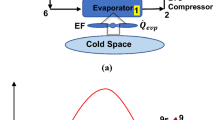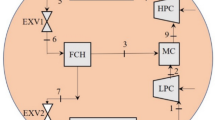Abstract
The paper presents the thermo-economic performance comparison of a two-stage refrigeration system using five different refrigerants, namely R32, R290, R1270, R143a and R410A. Refrigerants are selected based on their nearly similar thermo-physical properties. Evaporator and condenser temperatures are varied from − 35 to − 21 °C and 40–55 °C, respectively, to evaluate different thermodynamic and economic performances of the system. COP, mass flow rate, volumetric cooling capacity and discharge temperature of compressor have been chosen as energetic performance parameters, exergetic efficiency has been taken as exergetic performance parameter, and annualized cost rate is selected as economic criteria for this study. It is observed that refrigerants R290 and R1270 show the best performances in terms of COP, exergetic efficiency, mass flow rate and plant cost rate. Nearly, 4–4.4% higher COP, 3.5–4% higher exergetic efficiency, 1.9–2.1% lower plant annual cost rate are predicted using refrigerants R290 and R1270 compared to R410A. However, lowest compressor discharge temperature (nearly 20% compared to R410A) is attained with R290 and R143a. It is also found that the similar size of R410A compressor can be used only for refrigerant R32, whereas bigger size of compressor compared to R410A is needed in case of R290-, R1270- and R143a-based system. Finally, the authors have conducted multi-criteria optimization to find out the best suitable replacement of refrigerant R410A and identified R1270 and R32 to be the best possible replacements of R410A.















Similar content being viewed by others
Abbreviations
- VCRS:
-
Vapour compression refrigeration system
- CRS:
-
Cascade refrigeration system
- GWP:
-
Global warming potential
- ODP:
-
Ozone depletion potential
- P :
-
Pressure
- \(\dot{Q}\) :
-
Rate of heat transfer
- h :
-
Specific enthalpy
- s :
-
Specific entropy
- \(\dot{W}\) :
-
Rate of work transfer
- η :
-
Efficiency
- \(\dot{m}\) :
-
Mass flow rate
- T :
-
Temperature
- A :
-
Area
- U :
-
Overall heat transfer coefficient
- LMTD:
-
Logarithmic mean temperature difference
- VCC:
-
Volumetric cooling capacity
- ρ :
-
Density
- δ :
-
Rate of exergy destruction
- ex:
-
Specific exergy
- C :
-
Cost
- \(\dot{C}\) :
-
Cost rate
- φ :
-
Maintenance factor
- i :
-
Interest rate
- n :
-
Plant lifetime
- CRF:
-
Capital recovery factor
- N :
-
Annual operational hour
- μ :
-
Emission factor
- eva:
-
Evaporator
- cond:
-
Condenser
- comp:
-
Compressor
- TV:
-
Throttle valve
- FT:
-
Flash tank
- LP:
-
Low pressure
- HP:
-
High pressure
- s:
-
Isentropic
- out:
-
Outlet
- in:
-
Inlet
- 1, 2, 3, ….:
-
State point
- 0:
-
Dead state
References
Dincer I (2017) Refrigeration systems and applications. Wiley
Baakeem SS, Orfi J, Alabdulkarem A (2018) Optimization of a multistage vapor-compression refrigeration system for various refrigerants. Appl Therm Eng 136:84–96
Doménech RL, López RC, Alcaraz ET (2007) Experimental energetic analysis of the liquid injection effect in a two-stage refrigeration facility using a compound compressor. HVAC&R Res 13:819–832
Roy R, Mandal BK (2019) Energetic and exergetic performance comparison of cascade refrigeration system using R170–R161 and R41–R404A as refrigerant pairs. Heat Mass Transf 55(3):723–731
Chowdhury S, Roy R, Mandal BK (2019) A Review on energy and exergy analysis of two-stage vapour compression refrigeration system. Int J Air-Cond Refrig 27(02):1930001
Mohanraj M, Jayaraj S, Muraleedharan C (2009) Environment friendly alternatives to halogenated refrigerants—a review. Int J Greenh Gas Control 3(1):108–119
Emani MS, Roy R, Mandal BK (2017) Development of refrigerants: a brief review. Indian J Sci Res 14(2):175–181
Ahamed JU, Saidur R, Masjuki HH (2011) A review on exergy analysis of vapor compression refrigeration system. Renew Sustain Energy Rev 15(3):1593–1600
Heath EA (2017) Amendment to the Montreal protocol on substances that deplete the ozone layer (Kigali amendment). Int Leg Mater 56(1):193–205
Xu X, Hwang Y, Radermacher R (2013) Performance comparison of R410A and R32 in vapor injection cycles. Int J Refrig 36(3):892–903
Tu X, Liang X, Zhuang R (2011) Study of R32 refrigerant for residential air-conditioning applications. In: International congress of refrigeration
In S, Cho K, Lim B, Kim H, Youn B (2014) Performance test of residential heat pump after partial optimization using low GWP refrigerants. Appl Therm Eng 72(2):315–322
Piao CC, Taira S, Moriwaki M, Tanimoto K, Mochizuki K, Nakai A (2012) Alternatives to high GWP HFC refrigerants: residential and small commercial unitary equipment. In: ASHRAE/NIST refrigerants conference
Alabdulkarem A, Eldeeb R, Hwang Y, Aute V, Radermacher R (2015) Testing, simulation and soft-optimization of R410A low-GWP alternatives in heat pump system. Int J Refrig 60:106–117
Barve A, Cremaschi L (2012) Drop-in performance of low GWP refrigerants in a heat pump system for residential applications. In: International refrigeration and air conditioning conference
Zilio C, Brignoli R, Kaemmer N, Bella B (2015) Energy efficiency of a reversible refrigeration unit using R410A or R32. Sci Technol Built Environ 21(5):502–514
Roy R, Mandal BK (2014) First law and second law analysis of mechanical vapour compression refrigeration system using refrigerants CFC12, R134a and R290. Int J Curr Eng Technol Spec 3:191–195
Nikolaidis C, Probert D (1998) Exergy-method analysis of a two-stage vapour-compression refrigeration-plants performance. Appl Energy 60(4):241–256
Tiedeman JS, Sherif SA (2003) Optimum coefficient of performance and exergetic efficiency of a two-stage vapour compression refrigeration system. Proc Inst Mech Eng Part C J Mech Eng Sci 217(9):1027–1037
Ouadha A, En-Nacer M, Adjlout L, Imine O (2005) Exergy analysis of a two-stage refrigeration cycle using two natural substitutes of HCFC22. Int J Exergy 2(1):14–30
Zubair SM, Yaqub M, Khan SH (1996) Second-law-based thermodynamic analysis of two-stage and mechanical-subcooling refrigeration cycles. Int J Refrig 19(8):506–516
Agrawal N, Bhattacharyya S (2007) Studies on a two-stage transcritical carbon dioxide heat pump cycle with flash intercooling. Appl Therm Eng 27(2–3):299–305
Kılıç B (2012) Exergy analysis of vapor compression refrigeration cycle with two-stage and intercooler. Heat Mass Transf 48(7):1207–1217
Purohit N, Gupta DK, Dasgupta MS (2016) Effect of inter-stage pressure on the performance of a two stage refrigeration cycle using inter cooler. Energy Procedia 90:171–178
Aminyavari M, Najafi B, Shirazi A, Rinaldi F (2014) Exergetic, economic and environmental (3E) analyses, and multi-objective optimization of a CO2/NH3 cascade refrigeration system. Appl Therm Eng 65(1–2):42–50
Roy R, Mandal BK (2020) Thermo-economic analysis and multi-objective optimization of vapour cascade refrigeration system using different refrigerant combinations: a comparative study. J Therm Anal Calorim 139:3247–3261
Roy R, Bhowal AJ, Mandal BK (2020) Exergy and cost optimization of a two-stage refrigeration system using refrigerant R32 and R410A. ASME J Therm Sci Eng Appl 12(3):031024–031031
Mosaffa AH, Farshi LG, Ferreira CI, Rosen MA (2016) Exergoeconomic and environmental analyses of CO2/NH3 cascade refrigeration systems equipped with different types of flash tank intercoolers. Energy Convers Manag 117:442–453
Klein SA, Alvarado FL (1992) EES: engineering equation solver for the Microsoft Windows operating system. F-Chart software
Calm JM, Hourahan GC (2001) Refrigerant data summary. Eng Syst 18(11):74–88
Prasad M (1983) Refrigeration and air-conditioning. Wiley Eastern Ltd., New Delhi
Zubair SM, Khan SH (1995) On optimum interstage pressure for two-stage and mechanical-subcooling vapor-compression refrigeration cycles. J Sol Energy Eng 117(1):64–66
Arora CP, Dhar PL (1973) Optimization of multistage compressors, progress in refrigeration science and technology. IIR (Paris) 2:693–700
Tian C, Liang N, Shi W, Li X (2006) Development and experimental investigation on two-stage compression variable frequency air source heat pump. In: International refrigeration and air conditioning conference. Paper 799
Sayyaadi H, Nejatolahi M (2011) Multi-objective optimization of a cooling tower assisted vapor compression refrigeration system. Int J Refrig 34(1):243–256
Vali SS, Babu TPA (2018) Thermodynamic performance analysis and flammability study of various new ozone friendly non azeotropic refrigerant mixtures as alternatives to replace R22 used in residential air conditioners. Int J Heat Technol 36(4):1470–1481
Arora A, Kaushik SC (2008) Theoretical analysis of a vapour compression refrigeration system with R502, R404A and R507A. Int J Refrig 31(6):998–1005
Roy R, Mandal BK (2017) Thermodynamic analysis of modified vapour compression refrigeration system using R-134a. Energy Procedia 109:227–234
Roy R, Bhowal AJ, Mandal BK (2021) Thermoeconomic analysis of vapor compression refrigeration system with dedicated subcooler for high-temperature lift applications. ASME J Therm Sci Eng Appl 13:061005–1
Roy R, Mandal BK (2018) Exergy analysis of cascade refrigeration system working with refrigerant pairs R41–R404A and R41–R161. IOP Conf Ser Mater Sci Eng 377(1):012036
Sanaye S, Shirazi A (2013) Four E analysis and multi-objective optimization of an ice thermal energy storage for air-conditioning applications. Int J Refrig 36(3):828–841
Wang J, Zhai ZJ, Jing Y, Zhang C (2010) Particle swarm optimization for redundant building cooling heating and power system. Appl Energy 87(12):3668–3679
Lemmon EW, Huber ML, Mclinden MO (2010) Reference fluid thermodynamic and transport properties (REFPROP), version 9.0. NIST Standard Reference Database 23. National Institute of Standard and Technology, Gaitherburg, MD
Shaik SV, Babu TA (2017) Thermodynamic performance analysis of eco friendly refrigerant mixtures to replace R22 used in air conditioning applications. Energy Procedia 109:56–63
Vali SS, Setty TP, Babu A (2018) Performance computation of window air conditioner with very low GWP near azeotropic refrigerant mixtures as a drop in substitutes to R22. In: MATEC web of conferences, vol 144. EDP Sciences, p 04007
Mancuhan E (2019) A comprehensive comparison between low and medium temperature application refrigerants at a two-stage refrigeration system with flash intercooling. Therm Sci Eng Prog 13:100357
Vali SS, Setty TP, Babu A (2018) Analytical computation of thermodynamic performance parameters of actual vapour compression refrigeration system with R22, R32, R134a, R152a, R290 and R1270. In: MATEC web of conferences, vol 144. EDP Sciences, p 04009
Funding
This research did not receive any specific grant from funding agencies in the public, commercial or not-for-profit sectors.
Author information
Authors and Affiliations
Corresponding author
Ethics declarations
Conflict of interest
The authors declare that they have no conflict of interest.
Additional information
Technical Editor: Guilherme Ribeiro.
Publisher's Note
Springer Nature remains neutral with regard to jurisdictional claims in published maps and institutional affiliations.
Rights and permissions
Springer Nature or its licensor (e.g. a society or other partner) holds exclusive rights to this article under a publishing agreement with the author(s) or other rightsholder(s); author self-archiving of the accepted manuscript version of this article is solely governed by the terms of such publishing agreement and applicable law.
About this article
Cite this article
Roy, R., Mandal, B.K. Energy, exergy and economic optimization of a two-stage refrigeration system using low-GWP alternative refrigerants for high-temperature lift applications. J Braz. Soc. Mech. Sci. Eng. 45, 403 (2023). https://doi.org/10.1007/s40430-023-04320-9
Received:
Accepted:
Published:
DOI: https://doi.org/10.1007/s40430-023-04320-9




